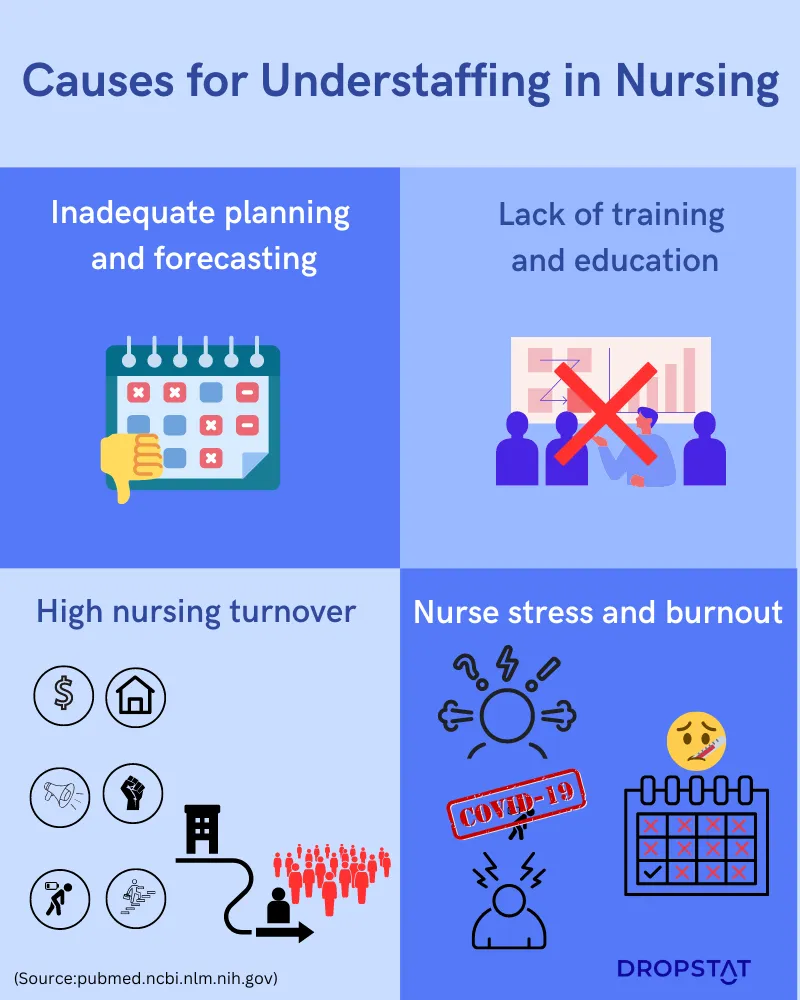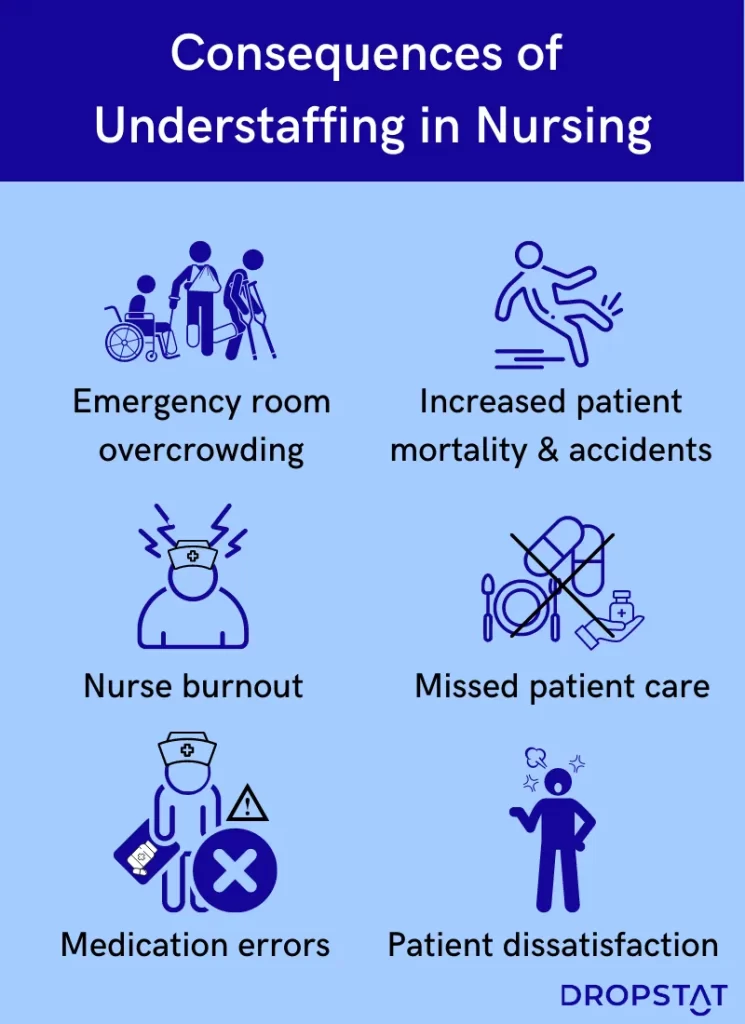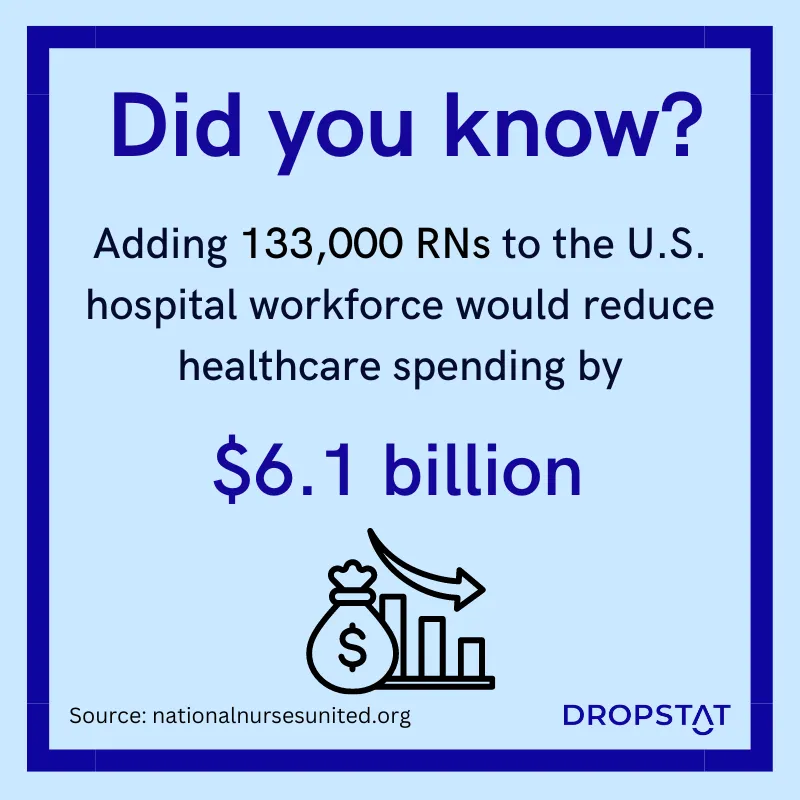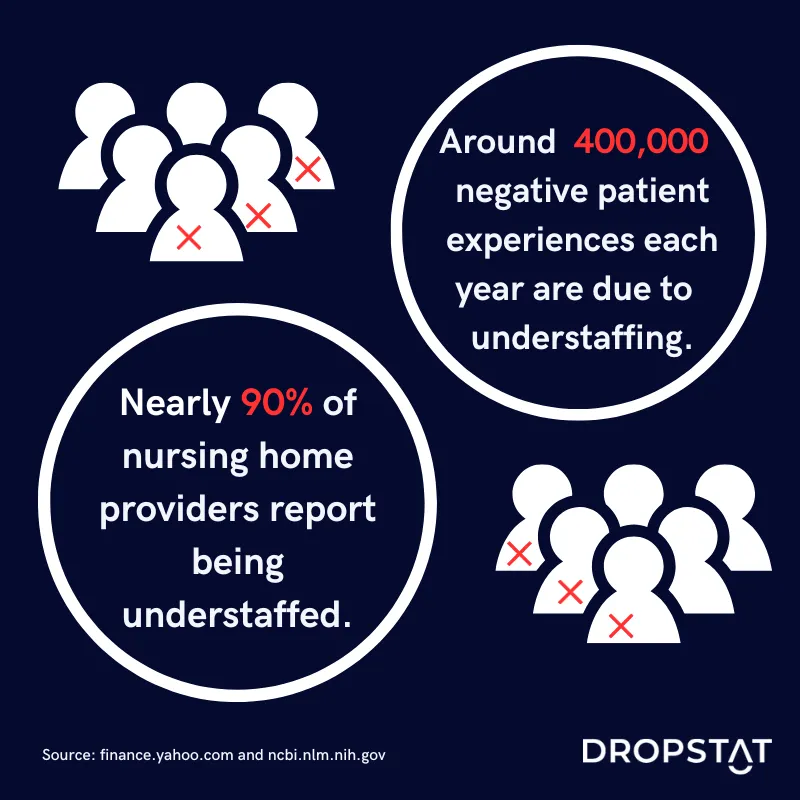Healthcare facility managers can ensure safe nurse-to-patient ratios through HPPD nursing, as the American Nurses Association (ANA) recommends. But calculating and committing to healthy nurse-to-patient ratios is only one step in the staff planning chain.
What is understaffing in nursing?
Understaffing in nursing occurs when there are staffing shortages because there are not enough nurses or nurses with the right qualifications in nursing homes or hospital settings.
Signs that healthcare facilities are understaffed include:
- Not enough nurses are signing in for their shifts.
- Neglect or reduced patient care.
- Nurses are shouldering an unfair or impossible workload.
- High nurse burnout and turnover rates.
- Constantly filling shifts with expensive overtime and agency staff.
- Admin and paperwork are falling behind.
- Patients and their families go looking for staff to administer care.
- Standard procedures – like patient intake and release – take too long.

Common causes of understaffed hospitals and nursing homes
Here are some of the main causes of understaffing in nursing:
- Nursing homes and hospitals don’t employ enough staff in an effort to save resources. This issue is often a result of budget constraints, prioritizing cost-cutting measures over staffing levels.
- There is a high nurse turnover rate in healthcare as a result of mandatory overtime and poor working conditions, which has led to staffing shortages in healthcare. High turnover rates mean that nurses leave facilities either for better work conditions within the nursing profession, for retirement, or for a career change. The result is a lack of nurses. By 2025, researchers estimate that there will be a nursing supply gap of 10-20%.
- Fewer nurses train for nursing management positions as they see the disadvantages and pressure that nurse managers face, as well as the insufficient salary.
- Specific shifts may be understaffed due to the difficulty of working that shift. The pay differential for the night shift is insufficient in many hospitals. This makes the night shift hard to fill.
- At patient peak times, such as during holidays, healthcare facilities are often understaffed unless they make a special effort to avoid nurse understaffing.
- Absenteeism is common for shifts where nurses suffer under unpleasant nurse managers. Nurse bullying is a significant factor that disturbs staffing patterns.
The safety consequences of nurse understaffing for patient safety:
When there are not enough nurses to satisfy patient needs, the quality of direct patient care is compromised. Here are some examples:
- Patient injuries occur more often when nurses are less cautious due to being overworked and stressed.
- Missed nursing care: due to impossible workloads, nurses miss providing sufficient patient care on time.
- Understaffing and workarounds: due to a lack of qualified nurses, other nurses must get tasks done. They resort to using risky shortcuts or methodologies.
- Medical errors occur when there is a lack of communication amongst pressured staff or due to exhausted nurses who work overtime and are less alert when dispensing medication.
- Bed sores or muscular atrophy: due to a lack of nurses available to turn patients or nursing home residents every 2 hours.
- Increased risk of patient falls since patients get fed up with waiting and attempt to do things for themselves.
- Lack of timely and effective care: due to not having enough nurses to do things on time.
- Increased patient mortality: statistically, understaffing in nursing is associated with higher mortality rates.
As patient satisfaction decreases, more patients or nursing home residents will begin to express their dissatisfaction by leaving bad reviews and maybe even transferring to another place of care.
Prolonged hospital stays due to lack of healing progress, while not a safety issue, may cause higher costs for patients, resulting in dissatisfaction among patients and their families.

The consequences of healthcare understaffing for nurses
With hospitals understaffed, nurses who are on the patient care frontlines are also put at risk.
- Nurses working overtime are stressed and more prone to burnout, injury, and illness. Examples of risks to nurses are physical injuries, such as too much lifting, or being censured or sued for wrongly administering medications.
- Nurses have been giving in early resignation as they leave nursing for a profession without extreme physical and emotional demands. For example, the AANCN found that 66% of nurses in acute care considered leaving nursing after negative pandemic experiences related to being a nurse.
- Understaffing causes nurses to be overloaded with impossible workloads, which leads to physical and emotional damage, including anxiety, depression, tension, and lack of focus.
How to measure understaffing in hospitals and nursing homes
Understaffing is measurable. This means the understaffing situation in nursing is repairable, given the right tools and the right metrics.
The example below uses a hypothetical unit as the basis for calculating understaffing.
To calculate how understaffed a unit is, you need to know:
- How many patients are in the unit?
- What is the recommended nurse-to-patient ratio for the unit?
- How many staff are required to work?
- How many staff are scheduled to work?
How to calculate nurse understaffing
There are 8 patients in a critical care unit.
For the 8:00 a.m. to 4:00 p.m. shift, 4 staff members are working.
The recommended minimum nurse-to-patient ratio is 1:2 for the critical care unit, which means one nurse for every 2 patients is acceptable.
If 1 nurse may care for 2 patients, then 4 nurses may care for 8 patients.
We calculate that at least 4 nurses must work in this hypothetical unit. Otherwise, the unit will be understaffed.
Compare the number of staff required to work with the number of staff actually scheduled to work. The number should be the same.

By collecting and using statistics, you can calculate whether an entire healthcare facility is affected by personnel understaffing, each floor, each unit, or each shift.
An important statistic to take into account in retrospect is how many staff actually worked each shift. With up-to-date attendance figures, you will have a more accurate outcome. This is imperative to ensure the facility is HPPD compliant.
Solutions to understaffing in healthcare
Investing in recruitment and retention programs
One of the most effective long-term solutions to understaffing in nursing is to invest in recruitment and retention programs that attract and retain high-quality nursing staff. This may include offering competitive salaries and benefits and providing ongoing training and professional development opportunities. By investing in your nursing staff, you can help ensure that your staff value working in your facility and that they will be dedicated to providing quality care to the patients or nursing home residents.
Effective staff scheduling
Another solution is to create a staffing plan that your nurses approve of. This will help to reduce nurse fatigue and nurse burnout. Making staff schedules manageable and flexible where possible will encourage staff members to work their shifts diligently. Absenteeism commonly occurs when employees feel they can’t handle their shifts. The American Institute of Stress estimates that 1 million workers are absent daily because of workplace stress.
Safe staffing ratios
Meeting the required safe staffing ratios based on patient acuity will help relieve staff members of workload stress. Many nurses quit nursing because they are upset about having to carry an unfair workload due to understaffing. Healthcare CEOs must think carefully before hiring, to understand the needs of the facility: how many nurses of each discipline are required? Does the facility need licensed practical nurses (LPNs), registered nurses (RNs), or nursing assistants? Hiring enough nurses with the right skill set and qualifications will ensure that nurses are not required to carry out unmanageable tasks.

Workplace health and safety
Healthcare CEOs can take steps to improve workplace safety and minimize the risk of injury and illness among nursing staff. This may include investing in ergonomic equipment, providing regular safety training, and implementing safety protocols to improve staff safety. This will save staff from illness and injury, further reducing avoidable sick days and absences.
The root causes of understaffing in nursing are complex. These solutions are practical and require time and manpower to implement them. Some solutions can be managed with the right technology, which will free up top-level nurses and nurse managers to guide their staff and be with the patients more, as you will see below.
How Dropstat helps prevent nurse understaffing
Dropstat is a staff scheduling app that uses AI and machine learning to predict staffing needs and fill shifts 60 days in advance. Dropstat identifies and predicts shifts that would be understaffed well ahead of the actual nursing shifts and communicate those unfilled shifts to all qualified internal teams. Nurses who are able to pick up open shifts can do so through the clear, user-friendly app easily and instantly. If the internal staff pool is not able to cover the gaps sufficiently, external healthcare workers that the facility has vetted are invited to pick up those gap shifts.
Dropstat is also fully integrated with the facility’s staff attendance program, which allows it to instantaneously calculate the facility’s staffing needs in an accurate manner with real-time attendance metrics.
With Dropstat, healthcare CEOs can rest assured that their facilities have the staff they need to provide quality care to patients and create a safe and supportive work environment for their nursing staff.







